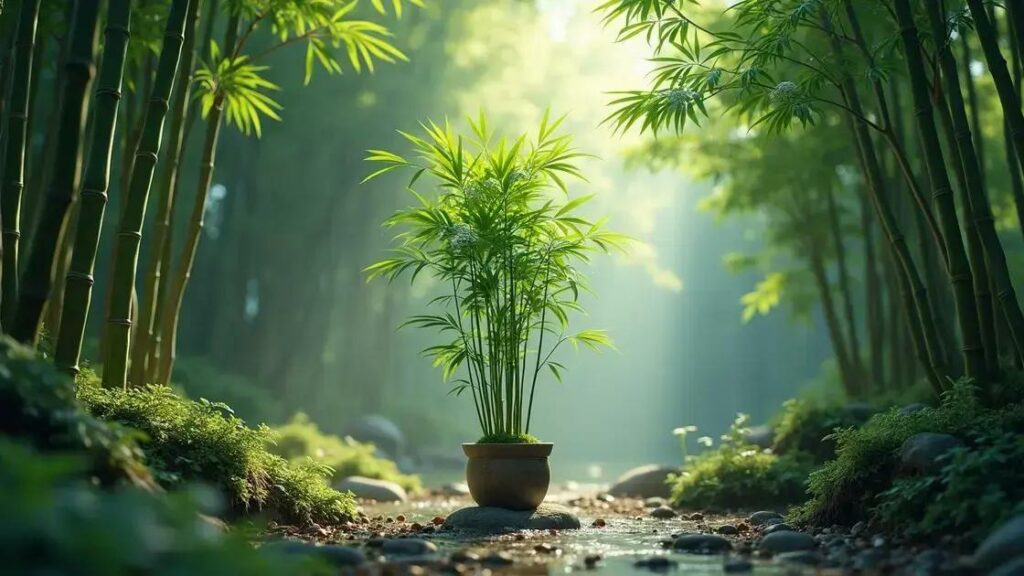How to take care of lucky bamboo plant is an artful balance of simplicity and attentive care. Whether you’re a beginner or seasoned plant enthusiast, nurturing this unique plant can be incredibly rewarding. We’ll delve into various aspects, from watering practices to optimal lighting necessities, ensuring your lucky bamboo flourishes beautifully in your space.
Table of Contents
ToggleUnderstanding lucky bamboo water needs
Understanding lucky bamboo water needs is essential for maintaining this unique houseplant. To ensure your lucky bamboo thrives, it’s vital to provide the right amount of water and regular maintenance.
Watering practices for lucky bamboo
- Use distilled or purified water to avoid chemicals that may harm the plant.
- Change the water every two weeks to prevent stagnation and algae buildup.
- Aim to keep the roots submerged but avoid over-saturation of the stalks.
Optimal water conditions
When caring for your lucky bamboo, be aware of the following water conditions that promote growth:
- Keep the water at room temperature for optimal absorption.
- Avoid using mineral-heavy tap water; if necessary, let it sit for 24 hours before use.
- Maintain a regular watering schedule to keep moisture levels consistent.
Common signs of water issues
Be vigilant for signs indicating improper watering:
- Yellowing leaves: This may indicate overwatering or exposure to chemicals. Check water quality and adjust your care regimen.
- Wilting stalks: This can occur due to underwatering, signaling that your lucky bamboo requires more moisture.
- Stunted growth: Inconsistent watering can halt plant progress, so ensure a balanced approach.
Additional tips for water care
- Consider using a water pump for larger setups to maintain circulation.
- Incorporate a water level indicator if you have many lucky bamboo plants to monitor their needs effectively.
For further enhancements, you might want to learn about exploring indoor gardening techniques that complement your lucky bamboo watering strategy.
Remember, understanding how to take care of lucky bamboo plants involves paying close attention to their water needs, ensuring your plant remains vibrant and healthy.
Optimal light conditions for lucky bamboo plants

Optimal light conditions for lucky bamboo plants are essential to ensure their healthy growth. Providing the right amount of light can make all the difference in how vibrant and strong your lucky bamboo becomes.
Best light sources for lucky bamboo
- Bright, indirect sunlight is ideal for lucky bamboo.
- Avoid direct sunlight, as it can scorch the leaves.
- Places near east or north-facing windows often provide the best conditions.
Signs of proper lighting
Recognizing that your lucky bamboo is thriving under optimal light conditions can be indicated by:
- Bright green leaves: Healthy foliage indicates proper exposure to light.
- Steady growth: Consistent height gain shows the plant is getting enough energy from light.
- Minimal leaf drop: If the plant sheds leaves, it might not be receiving sufficient light.
Adjusting light conditions
In some situations, your lucky bamboo may require adjustments in light exposure. Consider the following steps:
- Relocate your plant to a more suitable spot if it’s too dark or too bright.
- Rotate the plant periodically to ensure all sides receive light evenly.
- If using artificial light, opt for full-spectrum grow lights for the best growth.
Common light-related problems
Be aware of issues caused by improper lighting:
- Yellowing leaves: Indicates too much direct sunlight.
- Stretching or drooping: This suggests your bamboo is reaching for light.
- Brown tips on leaves: A sign of low humidity and potential lighting issues.
To create the best environment for your lucky bamboo, consider exploring indoor gardening techniques that can complement your lighting strategies.
Understanding the optimal light conditions for lucky bamboo plants can help you cultivate a flourishing indoor garden that thrives and brings vitality into your space.
Common lucky bamboo plant problems and solutions
Common lucky bamboo plant problems and solutions include issues that can affect the health of your plants. Identifying and addressing these problems promptly is essential for keeping your lucky bamboo thriving.
Identifying yellowing leaves
- Yellowing leaves can be caused by overwatering, poor light conditions, or nutrient deficiencies.
- Check the plant’s watering schedule to ensure it is not too frequent or insufficient.
- Evaluate the light environment; ensure the plant receives bright, indirect sunlight.
Solutions for leaf droop
If your bamboo leaves are drooping, consider these steps:
- Adjust your watering habits. Ensure the roots are well-fed but avoid waterlogging.
- Move the plant to a brighter location if it is too shaded.
- Monitor humidity levels, as low humidity can lead to drooping.
Handling root rot
Root rot is a critical concern and can occur from excess moisture. Address it by:
- Inspecting the roots; remove any black or mushy sections clearly affected by rot.
- Transplanting the healthy parts into fresh, well-draining soil to prevent recurrence.
- Reducing watering frequency to allow the remaining roots to recover.
Pest problems
Common pests, such as spider mites and mealybugs, can infest your lucky bamboo. Here’s how to tackle them:
- Inspect the plant regularly for signs of pests, like webbing or white cotton-like spots.
- Clean the plant with a damp cloth to remove bugs and potential breeding grounds.
- Use insecticidal soap or neem oil if infestations are significant.
For additional insights into improving your plant care routines, you might enjoy exploring indoor gardening techniques that can further enhance your lucky bamboo’s living conditions.
By understanding and addressing these common lucky bamboo plant problems, you can maintain a healthy and vibrant plant that adds beauty to your home.
In conclusion
Caring for lucky bamboo plants can be an enjoyable and rewarding experience when you understand their specific needs. From providing optimal light conditions to addressing common problems and implementing effective solutions, a little knowledge goes a long way in ensuring your bamboo thrives. By exploring the details we’ve discussed, you can establish a flourishing indoor garden that serves as a beautiful addition to your space.
For further guidance and tips on enhancing your indoor garden, continue learning and experimenting with different care methods.

